Fig. 19.1
ESA Astronaut Christer Fuglesang exercising on a bicycle ergometer on Shuttle middeck. Copyright NASA
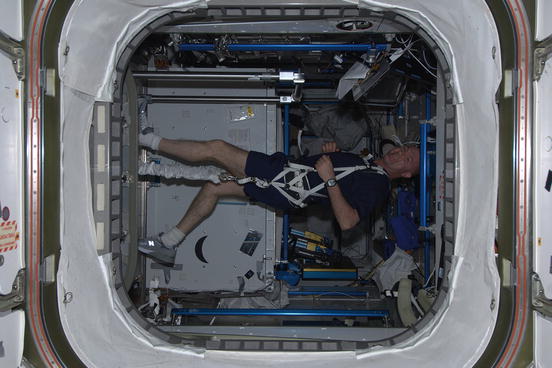
Fig. 19.2
ESA Astronaut Andre Kuipers exercising in Node 3 of the International Space Station (ISS). Copyright ESA
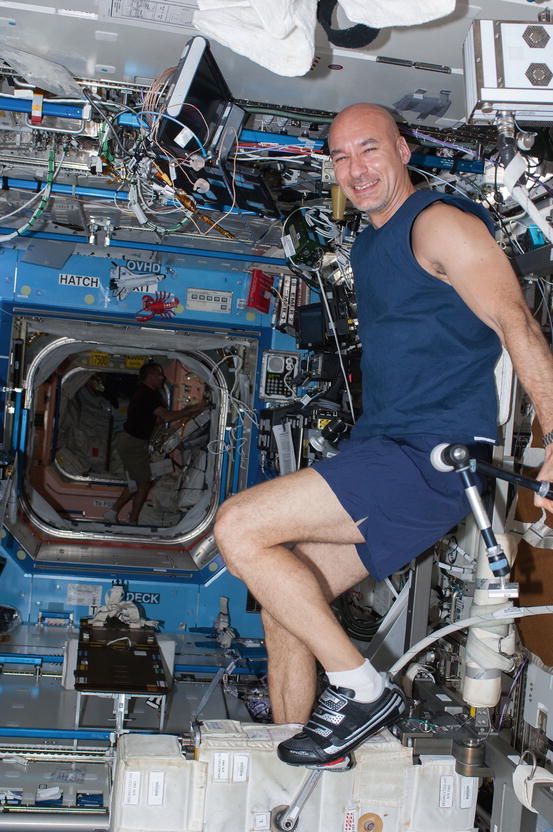
Fig. 19.3
ESA Astronaut Luca Parmitano biking in space. Copyright ESA
With regard to the positive effects of exercise on numerous physiological systems, so far exercise science in space has widely neglected the benefit of exercise on psychological parameters like mood and cognitive performance. This is of major interest as the duration of space missions is significantly increasing. Whereas early missions had a duration of several days only, currently the average inhabitation on the International Space Station (ISS) is 6 months. Moreover national and international space agencies are seriously considering a trip to Mars (Fig. 19.4).


Fig. 19.4
Art work of ESAs exploration missions. Copyright ESA
While exercise in space, from a physiological point seems insignificant for mission success, its impact on psychological parameters during prolonged space flight might be regarded as essential for mission success and safety on board.
19.2 The Physical Benefit of Exercise
The adaptation or deadaptation of physiological systems such as the musculoskeletal or cardiovascular system under missing gravity conditions is an extremely interesting field of research and has provided us within the last four decades not only with interesting but also important information, which are nowadays widely used inter alia in the rehabilitation of patients suffering from the negative effects of immobilisation, e.g. after surgery. Everyone agrees that an adequate exercise program in space prevents from physiological deconditioning of muscles, bones as well as the cardiovascular system, which helps astronauts and cosmonauts after long duration spaceflight to quickly readapt to earth gravity (Fig. 19.5).
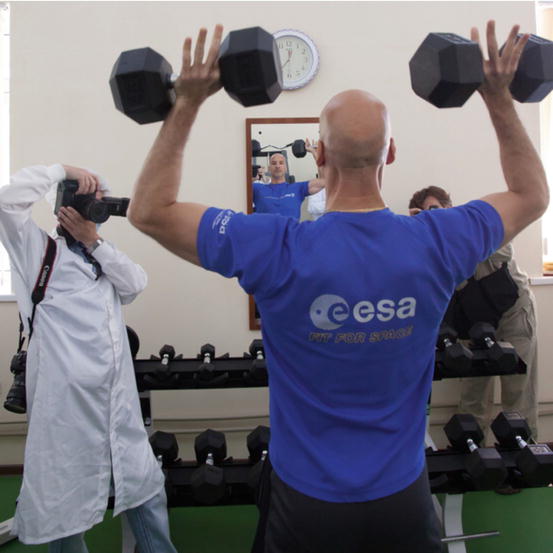

Fig. 19.5
ESA Astronaut Luca Parmitano during work out while preparing for space flight. Copyright ESA
Nevertheless, regarding performance optimisation and workload while living in zero gravity, exercise seems wasted time: A fundamental principle about the adaptation of bones and muscles is that if being used, they will increase their strength, while if not in use strength and stability will deteriorate. On earth, even if we don’t exercise, our musculoskeletal system is adapted to the load of daily living (walking, standing upright, carrying a box of water, etc.). The fact that there is a decrease of muscle mass as well as a decrease of bone stability especially in the lower extremities in space, simply is due to the fact that the musculoskeletal system is not used adequately, or, to say it the other way round, is not required. A recent paper by Gopalakrishnan et al. (2010) very nicely demonstrated that muscle mass and strength for the upper extremities shows no major changes across a time frame of approx. 6 months and also the strength losses in the ankle dorsiflexor group was neglectable, due to the regular use of foot loops, which are used to align and move the body against the resistance of inertial forces. This shows that muscles, that are used and that are useful, do not show any loss of strength in space whereas those that seem useless in space (e.g. calf muscles) degrade. The same thing is true for the cardiovascular system. There is an adaptation when permanently exposed to weightlessness, namely a decrease of heart rate similar to a supine position on earth (Verheyden et al. 2010)1 – which seems not to be a problem unless returning to earth gravity where orthostatic problems arise.
To conclude, keeping up muscle strength and volume by regular exercise is not a key factor for performance and mission success during space missions. Nevertheless two reasons exist to further explore and understand the detrimental effect of weightlessness on the musculoskeletal and the cardiovascular system and the role exercise plays in counteracting this deadaptation: (1) the benefit for individuals returning from long duration space flights experiencing a quicker rehabilitation and (2) the possibility to translate these findings into a benefit for an aging society helping to understand the underling physiological processes of degeneration and help to address adequate countermeasure, especially exercise (Figs. 19.6).
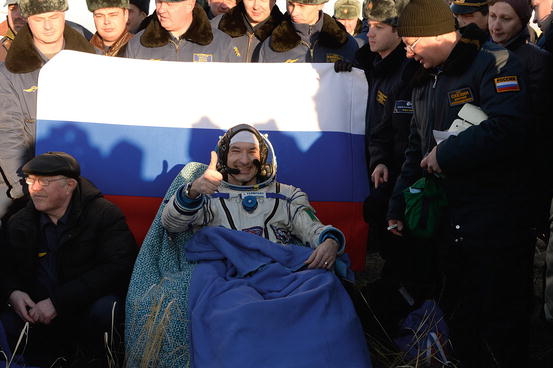

Fig. 19.6
ESA Astronaut Luca Parmitano back on earth after Expedition 36/37 (Soyuz TMA-09M). Copyright ESA
Nevertheless we need to be aware of the fact, that exercise has a second dimension, which so far has been widely disregarded in space science and also in health sciences.
19.3 The Mental Benefit of Exercise
Living in space is characterized by a number of psycho-physiological stressors (Fowler and Manzey 2000; Manzey 2000). While during short term space missions and in the beginning of long term space flights, physiological stressors dominate, with on-going duration the hostile environment, the limitations in the space habitat, the tremendous mission workload and last not least the social situation on board have been identified as main stressors. From studies of the last 20 years we know that this multistressor environment has a negative impact on cognitive performance, mental health and mood (Fowler and Manzey 2000; Kanas 1998) and therefore affects mission success and safety (Palinkas 2001). Although the underlying neurophysiological processes remain widely unclear, which is due to missing imaging technologies in space, recent research let us assume that microgravity itself (Schneider et al. 2008a; Cheron et al. 2006) but also the confinement within an isolated environment (Schneider et al. 2010b) contribute to changes in brain cortical function which might manifest in a decrease of cognitive performance, mental health and mood (Fig. 19.7).
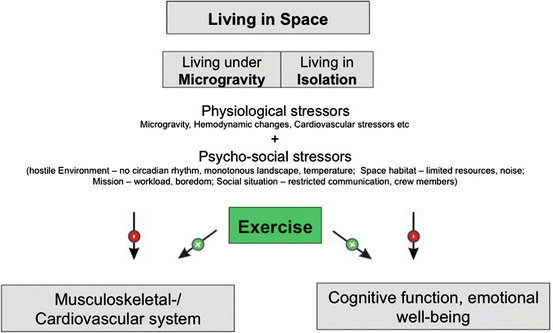

Fig. 19.7
Multi-dimensional stressors during spaceflight are know to have a negative impact on the musculoskeletal and cardiovascular but also on the cognitive and affective systems of space travellers. In contrast exercise is known to positively affect the physiological as well as psychological systems and therefore might be identified as a holistic countermeasure guaranteeing the maintenance of health during long-term spaceflight missions
Whereas the positive effects of regular as well as acute exercise on cognitive performance, mental health and mood have been substantially investigated throughout the last two decades in earth-bound studies, it was only in the past few years that research has indicated that these positive effects of exercise are caused by changes in brain cortical function. Especially (pre-)frontal brain regions, which are well known to play a major role in information as well as emotional processing, seem to be affected by exercise. Two major theories have been developed to explain these effects, the transient hypofrontality hypothesis by Dietrich (2006) and the dual-mode theory by Ekkekakis and Acevedo (2006). Both theories assume that exercise is accompanied by a redistribution of CNS activity to regions that are involved into planning and executing motor commands (mainly the motor cortex, supplementary motor areas and sensory cortex) and therefore regions not involved into the demanding task of exercise (as fronto-temporal areas of the brain) show less activity. If we regard the brain as a multiprocessor unit, than exercise is able to reduce clock frequency in specific and essential processors (because calculating capacity is used elsewhere) and this seems to reset basic procedures (e.g. cognitive and emotional processing).
Within the next paragraphs we would like to review several studies performed during the last years demonstrating the positive effects of exercise on mood and cognitive performance, which will guide us to the assumption that exercise in space might be an important tool for individual performance optimisation and mission success.
19.4 Even a Short Bout of Exercise Is Able to Influence Mood and Cognitive Performance
The Mars500 program, initiated by the European Space Agency (ESA) and the Institute of Biomedical Problems (IBMP) in Moscow aimed to prepare for a human spaceflight to Mars. In the years 2010/11 six crewmembers lived in a confined environment, mimicking a space ship, located in the IBMP facilities in Moscow for 520 days. This includes a 485 days period of travelling to and from Mars as well as a 35 days period of Mars exploration. In order to prepare for this study, in the first half of 2009 a 105 day isolation study was performed to evaluate procedures and protocols. During this study we were able to perform several measurements of electro-cortical activity using electroencephalogram (EEG) as well as a profile of mood state (MoodMeter®) simultaneously before and after exercise (Figs. 19.8, 19.9, 19.10, 19.11, 19.12 and 19.13) (Video 19.2).
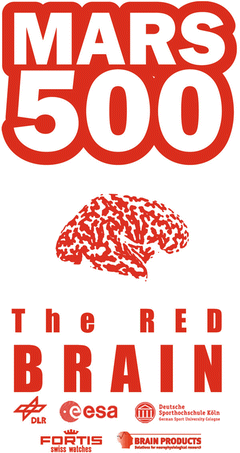
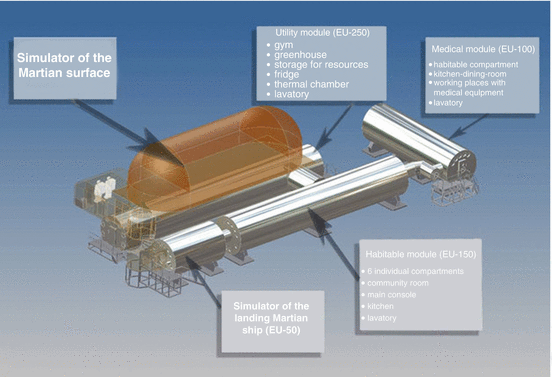
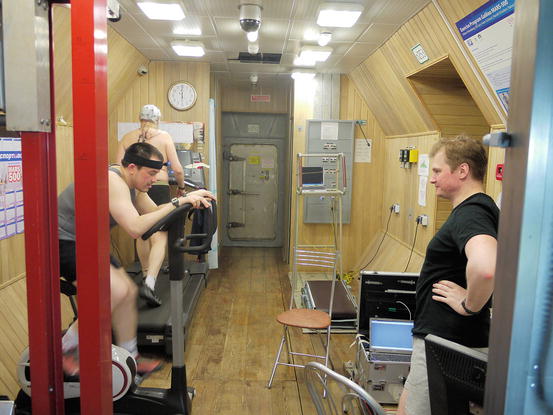
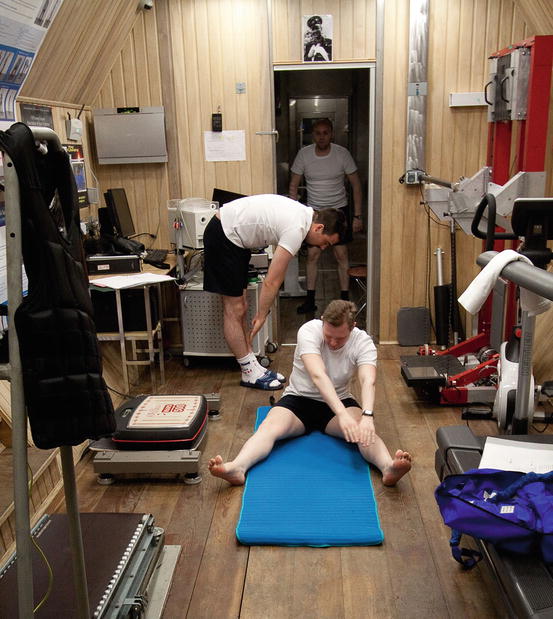
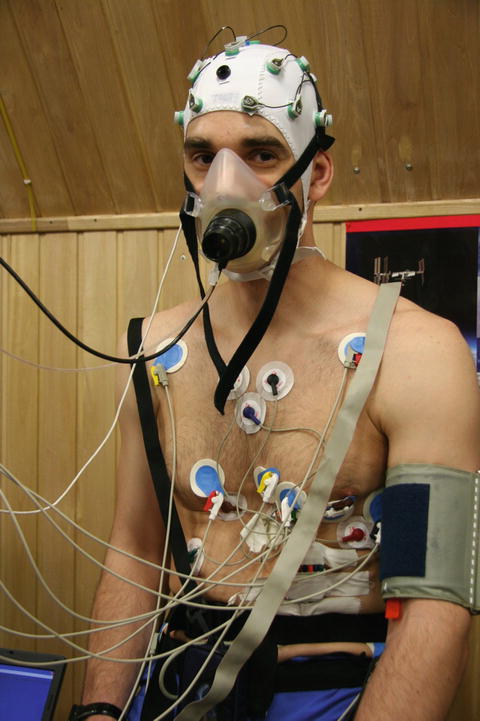
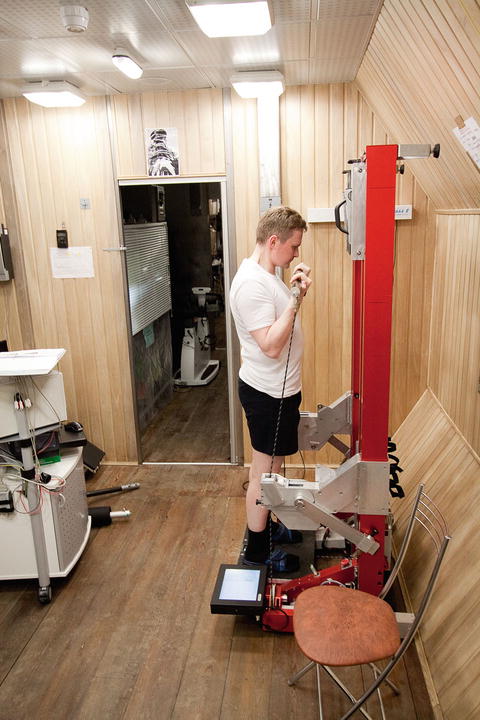

Fig. 19.8
Logo of the German Sport Universities contribution to the MARS500 program

Fig. 19.9
The Mars500 isolation facility located in the Institute of Biomedical Problems (IBMP) in Moscow. Copyright ESA

Fig. 19.10
Exercise within the MARS500 facilities. Copyright ESA

Fig. 19.11
Daily exercise routine during the MARS500 isolation study. Copyright ESA

Fig. 19.12
German participant Oliver Knickel during the MARS105 isolation study just before an exercise intervention test. Copyright ESA

Fig. 19.13
Russian participant of the MASR500 isolation study during chest workout. Copyright ESA
Cortical activity was defined by subdividing the raw EEG signal into its specific frequency ranges alpha [8–13 Hz] and beta [13–35 Hz]. While alpha activity generally reflects normal brain function, an increase in beta activity indicates excitatory CNS activity (Lindsley 1960; Zuckermann 1991; Bonnet and Arand 2001).
Using the MoodMeter®, a tool that was specifically designed to evaluate short term changes in mood (Schneider et al. 2008b, 2009a), we were able to evaluate the effects of exercise on perceived physical state, perceived motivation and perceived psychological state. Exercise consisted of a 10–12 min incremental exercise protocol starting with 30 W and increasing by 15 W every minute until 80 % of individuals’ maximal intensity on a bike ergometer. Data was recorded 12 days prior to exercise, on days 30, 64, 77 and 99 during the 105-day isolation as well as 8 days post isolation. A detailed description about methods and protocol can be found in Schneider et al. (2010b).
Results, displayed in Table 19.1, showed a clear influence of exercise on brain cortical function and perceived physical state. Two distinct processes seem noteworthy: At first, we could observe a decrease of activity in both EEG frequency ranges across the time frame of isolation. Whereas a general model of cortical arousal would assume an increase in the beta frequency range to result in a decrease of alpha activity, this was not the case here. With regard to the data (Table 19.1) it seems that the prolonged isolation results in an overall decrease of brain cortical activity, which was supposed to be a result of the confined situation with its specific stressors (loneliness, social stress, boredom, sensory deprivation etc.). Second, at any time point during the isolation, a small bout of exercise of about 10–12 min was able to increase brain cortical function back to baseline, pre-isolation values.
Table 19.1
Results of the MARS105 study
Perceived physical state | Perceived physical state | Perceived motivational state | Perceived motivational state | Perceived psychological state | Perceived psychological state |
|---|---|---|---|---|---|
PREEXERCISE | POSTEXERCISE | PREEXERCISE | POSTEXERCISE | PREEXERCISE | POSTEXERCISE |
3.11+/−1.67 | 3.12+/−1.74 | 3.33+/−0.93 | 3.83+/−1.19a
Stay updated, free articles. Join our Telegram channel
Full access? Get Clinical Tree
 Get Clinical Tree app for offline access
Get Clinical Tree app for offline access

|





